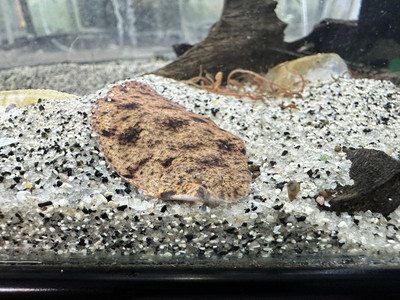Teardrop Flounder
Posted by Max Gandara on on 16th Aug 2024
The Teardrop Flounder: A Unique Addition to Your Aquarium
If you’re seeking a distinctive and captivating addition to your aquarium, the Teardrop Flounder is an excellent choice. Known for its unique appearance and fascinating behavior, this flatfish brings an intriguing element to any freshwater tank. Here’s everything you need to know about the Teardrop Flounder and why it might be the perfect addition to your aquatic setup.
1. Unique Appearance
The Teardrop Flounder, also known as Bothus lunatus, stands out due to its unusual shape and coloration. This flatfish features a teardrop-shaped body with an eye-catching pattern that can include various shades of brown, green, and orange. Its flattened body and asymmetrical eyes give it a distinctive look that sets it apart from more traditional aquarium fish. This unique appearance adds a touch of intrigue and elegance to your tank.
2. Fascinating Behavior
Teardrop Flounders are known for their remarkable behavior, including their ability to camouflage themselves against the substrate. They use their ability to blend in with their surroundings to evade predators and ambush prey. This natural camouflage behavior makes them an interesting species to observe, as you might spot them partially hidden among the gravel or sand in your tank.
3. Ideal Tank Conditions
To ensure your Teardrop Flounder thrives, provide the following tank conditions:
- Tank Size: A minimum of 30 gallons is recommended, as these fish require ample space to move and establish a territory.
- Temperature: They prefer a temperature range of 72-78°F (22-26°C).
- pH Level: Maintain a slightly acidic to neutral pH range, ideally between 6.5 and 7.5.
- Tank Setup: Provide a tank with a sandy or fine gravel substrate, as this mimics their natural habitat and allows them to bury themselves. Include hiding spots and gentle filtration to replicate their natural environment.
4. Diet and Feeding
Teardrop Flounders are carnivorous and will require a diet rich in protein. Feed them high-quality frozen or live foods such as worms, small shrimp, and small fish. Regular feeding of protein-rich foods will help maintain their health and coloration. Be mindful of their feeding habits, as they are primarily bottom-feeders and may require food to be placed directly on the substrate.
5. Peaceful Nature
The Teardrop Flounder is generally a peaceful species that gets along well with other non-aggressive fish. However, they can be territorial, especially in smaller tanks. It’s best to house them with other bottom-dwellers that are not overly aggressive and provide ample hiding spots to reduce territorial disputes. Avoid keeping them with fish that may view them as prey.
6. Tank Mates
Suitable tank mates for the Teardrop Flounder include other peaceful bottom-dwellers, small schooling fish, and non-aggressive species. Avoid housing them with larger or aggressive fish that might harass them or compete for food. A well-balanced community tank with appropriate tank mates will help ensure a harmonious environment.
7. Breeding and Reproduction
Breeding Teardrop Flounders in captivity can be challenging and is not commonly achieved by hobbyists. They are egg layers and lay their eggs in the substrate or among aquatic plants. Creating a stable and well-maintained tank environment with appropriate conditions may increase the chances of successful breeding, but it generally requires specific knowledge and care.
8. Benefits of Adding Teardrop Flounders
Incorporating Teardrop Flounders into your aquarium offers several benefits:
- Distinctive Appearance: Their unique shape and coloration add a special touch to your tank.
- Camouflage Behavior: Their ability to blend in with their surroundings provides an interesting observation experience.
- Peaceful Nature: They are generally peaceful and make a great addition to well-balanced community tanks.
9. Care Tips
To ensure the best care for your Teardrop Flounder:
- Monitor Water Quality: Regular water changes and monitoring of water parameters are essential for maintaining a healthy environment.
- Provide Hiding Spots: Include hiding spots and a sandy substrate to mimic their natural habitat and reduce stress.
- Feed Appropriately: Offer a varied diet of protein-rich foods to meet their dietary needs.
Conclusion
The Teardrop Flounder is a fascinating and unique addition to any freshwater aquarium. With its distinctive appearance, intriguing behavior, and peaceful nature, it adds both beauty and interest to your tank. Whether you’re a seasoned aquarist or new to the hobby, the Teardrop Flounder will enhance your aquarium with its unique charm and captivating presence.

